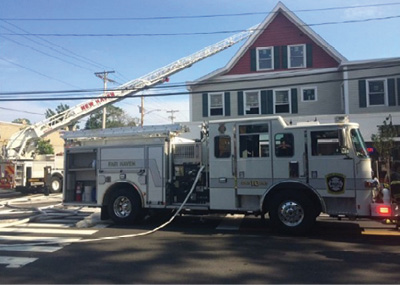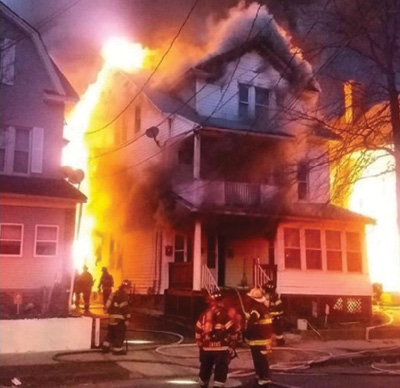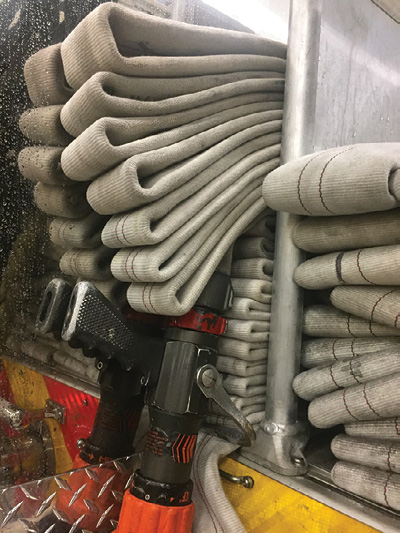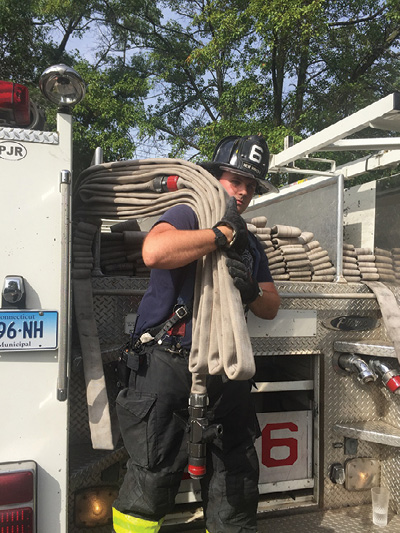

By JASON RIVERA
There is no more important task on the fireground than getting the nozzle to the seat of the fire as quickly and as efficiently as possible. But, how do we do this quickly and efficiently when the area we are trying to traverse is blocked by cars and trees and we must enter a house loaded with furniture, personal belongings, and various other “stuff” with limited staffing? I am not referring to this hypothetical house being like a “Collyer’s Mansion” (i.e., hoarding situation); I mean a house in “Everytown, USA.”
Whether you’re in the suburbs or the city, a single-family dwelling or an apartment building, there will be obstructions to the stretch. This doesn’t change the fact that we need to get the handline in place immediately, if not sooner.
The Initial Stretch
The hoseline stretch begins in the street, which involves apparatus placement. First and foremost, the engine needs to drive past the fire building to allow the ladder truck to park behind it as close as possible to the fire building (photo 1). You can always add hose, but you can’t stretch the aerial device. Throwing ground ladders can be very time- and staff-consuming, so stick the roof whenever safely possible. Also, on arrival, this allows the officer to see three sides of the building; a good engine chauffeur will position well beyond the fire building.
Next, the nozzleman must determine the distance between the hosebed and the front door. You need to decide if crews stretch off the rear or pull a crosslay. Stretching off the rear will typically give a direct route toward the fire building and save a little hose, while a crosslay will require more hose to be pulled, adding obstructions if you’re operating on a tight street with cars parked on both sides. Size up any obstructions (e.g., trees, cars, fences, and so on) and come up with a game plan on what the most direct route to the front door is and how much hose you need to get there.

(1) Photo by Brad Young.
Take note of how far the rig is parked from the building. In the suburbs, there may be considerable distance between the apparatus and the front door because of the large front yards, set-back buildings, and so on. In a more urban environment, buildings are typically much closer to the street with little or no front yard, thus reducing the amount of hose needed to reach the entrance. Whatever the case may be, you must make an accurate assessment of how much hose is needed to reach the entrance, keeping in mind that many buildings’ “front” entrances may be to the rear or side of the building.

(2) Photo by Trell Simmons.
Next, look at the interior of the building and estimate the worst-case scenario for how much hose you may need. You can safely estimate needing one length of hose per floor and one additional length to operate on the fire floor (the travel length). For example, if fire is showing on the third floor of a three-story multiple dwelling (photo 2), you will need one length to get from the front door to the second floor and one length to get from the second floor to the third. As stated earlier, you still need that travel length, so using this calculation requires about three lengths or 150 feet to traverse the interior of the building (don’t forget to calculate the amount of hose needed to reach the entrance, as stated earlier). You would need to increase this estimation in cases of large residential and commercial buildings or if you are using stairs in the rear. You must make all these calculations in a matter of seconds to begin your stretch.

(3) Photo by author.
Inside the building, you may come across a myriad of obstructions such as bicycles being stored in the stairwell, washers and dryers placed against doors, or large quantities of furniture and debris in rooms. You must work around this. The best way to advance hose around these obstructions is to maintain control of the hose on your shoulder. Be careful moving and throwing household items randomly around; a carelessly moved item may unintentionally cover up a victim on the floor or create problems for another crew’s hoseline. If items are to be moved, survey the area to where you are moving them and ensure that placing them in that location will not hinder anyone’s operation.
Making the Stretch
Whatever hose pack you use (e.g., minuteman, flat, triple layer, and so on), be familiar with it and practice deploying it on a regular basis. I’ve found that there is one hose pack that seems to surpass the others when working with limited staffing and obstructed stretches: the minuteman load (photo 3). The key to making a quick, smooth stretch is to deploy only the minimum amount of hose needed off your shoulder while keeping the remainder secured. The minuteman is easy to remove, and it remains in place without a great deal of effort. You can guide the hose around obstructions easily, and it can flake off the shoulder only when the nozzle person wants.

(4) Photo by author.
As the nozzleman stretches the line around objects, the trailing hose remains secured to the discharge on the engine; this prevents the hose from being dragged, which can lead to couplings getting caught and lines getting stuck under car tires. Whenever possible, a firefighter should flake out dropped hose neatly to assist with the hose stretch and prevent the line from becoming tangled or caught under or around obstructions. When the nozzleman approaches the door, he can place the hose load down to mask up, force the door, and then re-don the hose to complete the stretch or flake it out to be charged, as the situation dictates.
As the nozzleman ascends the stairs, he should lay out the hose to the outside of the stairs. If he encounters obstructions, he can remove or climb over/around them without losing any of the hose load.
If your estimates are correct, you should reach the fire floor with at least 50 feet on your shoulder (photo 4). You want to flake this hose out quickly either in the stairwell, up the stairs to the floor above, or on the floor below (depending on department policy and the situation encountered), then give a call to charge the line. Note that any belowgrade fire should require a charged hoseline at the front door prior to entry.
Another good rule of thumb is if the smoke condition prevents you from seeing the floor, the line should be charged. No firefighter wants to be caught in a hostile fire situation with an uncharged line.

(5) Photo by author.
If the line must be charged at the front door, lay out the line in a “U” or an “S” configuration that is perpendicular to the building (photo 5). Laying hose parallel to the building will create an immediate friction point before you even make entry, thus slowing your stretch. Most departments, at least initially, will not have sufficient staffing to place a firefighter at the front door to overcome this 90° bend. Set yourself up for success from the start!
You must make quick size-ups and decisions regarding your hoseline stretch on arrival. This includes being on the lookout for obstructions and estimating distances to the fire floor. Then, you must deploy the line quickly and prevent entanglements, which inhibit forward progress or—worse—result in being stuck in a bad spot inside the fire building. The best way to accomplish this is by maintaining control and keeping the hose pack on your shoulder during the stretch.
The only way to become proficient at this skill is through practice and repetition. Conduct company drills regularly! Stretching lines doesn’t have to be a big, formal deal. With a little bit of time and a lot of motivation, two or three firefighters can practice this skill regularly during some downtime at the firehouse and become very proficient. Make it a fun learning environment, and have competitions between teams to see who can get the line where it needs to go the quickest. Whatever the case is, just get out there and practice, because the next job your department goes to, you may have the nozzle.
JASON RIVERA is a 24-year fire service veteran who has served in career and volunteer departments. He is a firefighter for the New Haven (CT) Fire Department assigned to Squad Co. 2. Rivera retired as the captain of Rescue 1 for the Stamford (CT) Fire Department He is also the assistant chief for the Newtown (CT) Fire Department’s Hook and Ladder Fire Company. Rivera was the recipient of the Ray Downey Courage and Valor Award at FDIC International 2016.
RELATED
Hallway Hose Stretch
Simplifying the Hose Stretch with Strategically Placed Loops
Hose stretches in multiple-dwelling fires
PERSONNEL POSITIONS AND HOSE STRETCHES

